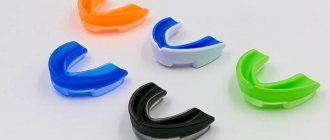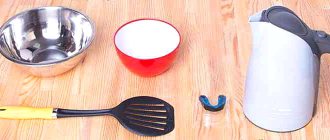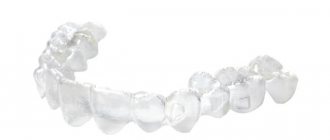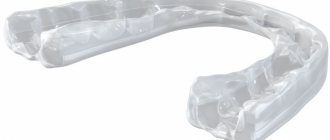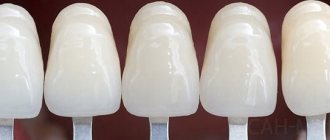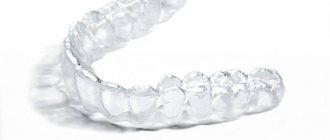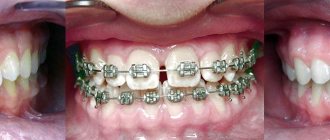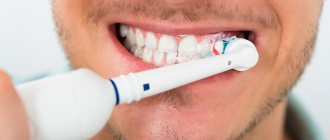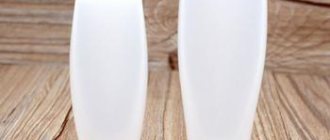Why cook kapa?
A mouth guard is a special rubber band that a boxer holds in his mouth during a fight. This is a mandatory part of every boxer's equipment. Its main function is protection from strong impacts and various types of injuries.
There are several types of this accessory:
- single-jawed;
- two-jawed.
The most popular are the single-jawed species.
Many novice athletes do not know why to cook the product, since it is sold already in finished form. The answer to this question is very simple - thanks to the cooking procedure, the rubber takes the shape of a jaw. And this accessory should fit snugly to the jaw. The degree of protection of teeth during combat depends on this.
Cooking technology
Having chosen a mouth guard for boxing, you then need to independently carry out the procedure of cooking it, or rather boiling it. The whole process is simple to perform, just follow the following sequence of actions:
- Boil water in a kettle or ladle.
- Take two containers and pour boiling water into one, and fill the second with clean cold water.
- First place the product in a vessel with boiling water and leave for exactly one minute. There is no need to overexpose it.
- After the specified time has passed, take out the mouthguard, place it between your jaws and bite down as hard as possible. While in boiling water, the rubber will soften well and easily take on the desired shape.
- Leave the tray in your mouth for about five minutes.
- After the specified time has passed, remove the mouthguard and place it in a container filled with cold water. This is necessary for the rubber to harden.
What should a year old child eat for breakfast?
The age of one is the time to instill proper eating habits in your child. Probably everyone has friends or relatives who do not eat certain types of cereals. Most often, this is due to the fact that the mother did not teach her to eat such porridge at an early age or did not cook it tastefully.
Porridge should make up 60% of the baby's diet. Their presence in the menu may look like this:
- Breakfast - milk porridge on its own or sweetened with water.
- Unsweetened porridge as a side dish for lunch, as a main course or soup with cereal.
- Dinner with a cereal side dish or homemade milk/water porridge.
Porridge for breakfast should become the rule, since such a product provides the child’s growing body with maximum energy. If cereals are present in lunch dishes, then there is no need to give porridge in the evening. And vice versa, for a vegetable/meat lunch, feed the child porridge in the evening.
Mouthguard fitting
As the temperature rises, the rubber softens. To fit it correctly, you need to remove it from boiling water, place it in cold water for one second and immediately fix it on the upper jaw.
There are several nuances to fitting a mouth guard:
- First the back part is fixed, and then the front;
- after the mouthguard is completely seated, it is pressed with your fingers to repeat the shape of the teeth and jaw;
- if a double-sided mouthguard is being adjusted, you cannot remove the plug from the holes until it takes the form of a bite;
- If it doesn’t work the first time, you can repeat the entire procedure.
If the mouth guard is correctly selected, it fits tightly on the upper jaw and does not require additional fixation.
There are two types of mouthguards - made of thermoplastic or silicone. The latter option does not require special adjustment and is easily fixed on the upper jaw, and no cooking is required.
Thermoplastic mouthguards are suitable for the classic brewing procedure. But you should always take into account the manufacturer's recommendations.
How are aligners different from braces?
Both mouthguards and braces are used to correct bites in adults and children, but these designs have significant differences that determine both the disadvantages and advantages of each of them. To make it easier for patients to navigate in choosing the appropriate correction method, below is a table with a comparative analysis of both systems.
Aligners or braces
Table. Mouth guards and braces: comparison.
| Characteristics | Mouthguards | Braces |
| The effectiveness of bite correction | Effective only for minor bite pathologies. | Can be used for severe deformation of the dental system (including severe and complicated cases). |
| Wearing period | From 8-10 months to 2 years. | From 1 year to 2-3 years. |
| Possibility of use in childhood | Can be used in childhood (treatment of bruxism using silicone teethers is especially common). | It is acceptable to use in children over 5 years of age, but the possible risks of enamel damage must be taken into account. |
| Visibility to others | Mouthguards are made of transparent silicone or bioplastic and are practically invisible on the teeth, which makes their use more comfortable and provides psychological comfort to the patient. | Vestibular braces, which are installed on the front surface of the teeth, are clearly visible to others. If these are ordinary metal braces, wearing such a design can cause emotional distress for the patient (especially children and adolescents). |
| Comfort to use | Adaptation to the aligners usually occurs almost immediately after installation. In rare cases, this process may take 3-5 days. | Nagging pain and discomfort when wearing braces can appear at any time as the teeth gradually shift. The duration of such periods can range from 2-3 days to several weeks. |
| Degree of gum trauma | Due to the soft materials, the mouthguards practically do not injure the mucous membranes and soft tissues of the oral cavity. | Braces can have a destructive effect on tooth enamel and damage the mucous membranes of the tongue, lips and gums. |
| Possibility of removal without visiting the dental office | Maybe. | Impossible. |
| Ease of hygienic care | The mouthguard can be easily removed from the mouth to clean the teeth and the structure itself, which ensures a high level of hygiene during orthodontic treatment. | The level of hygiene when using brace systems is quite low due to the inaccessibility of surfaces covered with orthodontic brackets and locks. |
| Price | From 6 to 15 thousand rubles for one mouth guard. | From 70,000 rubles. |
At first glance, it may seem that treatment with mouth guards is a cheaper option compared to braces, but this is not the case. Aligners must be changed regularly, and one set can contain up to 25-30 drops per course of treatment. The total cost of the course is usually more than 200 thousand rubles.
Diagram of the results of treatment with mouthguards
We invite you to read: Chronic periodontitis treatment - Dr. Dent
Rules for preparing mouthguard
Before you start cooking kapa, you need to carefully study the recommendations that will help you avoid common mistakes. There are several important rules:
- if the product has been overcooked, it must be thrown away immediately;
- When placing a product in hot water, it must not be completely immersed - it is important that it floats on the surface of the liquid;
- When squeezing your teeth to give the mouthguard the desired shape, you cannot move your jaw; it is important to firmly fix the product and hold it.
When the mouthguard is prepared correctly, it:
- has clear prints;
- holds tightly;
- does not create discomfort during use.
Question to an expert
Which mouth guard is best for a beginner?
The ideal choice is a two-jaw mouth guard. This model is suitable for both beginner athletes and women. The product provides maximum jaw protection at the initial level of training.
Good to know
Those who are just starting to train and are faced with the procedure for preparing a mouth guard for the first time should know a few important points.
- If the burl is cooked incorrectly, do not throw it away - the cooking procedure can be repeated.
- It is not advisable to purchase cheap mouth guards, as this can have a negative impact on your oral health.
- A properly prepared mouth guard should fit tightly. If it sits poorly, it means mistakes were made during the cooking process.
- It is recommended to change the mouthguard every season, since this means of protection tends to wear out over time, which leads to the loss of its protective functions.
- There is no need to try to drown it when placing it in a bowl of hot water - it should just float there.
- After each workout, rinse the mouthguard under running cold water, after brushing with a brush and toothpaste.
- A well-ventilated special container is required to store the mouth guard.
- Do not leave it in the sun - direct exposure to sunlight can lead to deformation.
- If the mouthguard is overcooked, then nothing can be done with it.
Boxing is a rather dangerous sport, as injuries are inevitable during training and competition. But an athlete should think first not about his career, but about his health. A correctly selected and properly prepared mouthguard will preserve the integrity of the teeth, tongue and soft tissues of the face.
Features of mouthguard care
This is an important part of using this accessory. It’s easy to care for your mouth guards by following these tips:
- need to be stored in a special container that will protect from dust and dirt;
- after the mouthguard has been removed from the jaw, it must be rinsed with plenty of running water;
- if necessary, it is allowed to periodically clean the product with toothpaste and a brush;
- Boiling water cannot be used for sanitization; for this purpose, special pharmacological agents are used, which are available in a wide range in pharmacies.
Common mistakes
The process of brewing burls does not always go without problems. It is difficult to cook a mouthguard incorrectly, but this happens when the product is placed in water at the wrong temperature;
- the accessory becomes hard when it is placed in cold or insufficiently heated water, as well as if it is kept at high temperatures for a long time (about 100 degrees Celsius);
- pimples appeared - the product was in boiling water for too long;
- if a thin and cheap burl is brewed, it can literally melt; to prevent this from happening, you must strictly adhere to the established temperature conditions and the time the product is in the water.
Nutrition for a one-year-old child: what cereals can be introduced to children aged 1 year?
In order for porridge to benefit the little person’s body, it is necessary to introduce cereals, according to medical recommendations, at a certain time. If a child turns one year old, he has already become acquainted with:
- corn, buckwheat and rice cereals at 6–8 months. These are the first gluten-free porridges introduced into complementary foods for babies;
- oatmeal – 8–10 months.
At one year, you can start feeding them porridges made from cereals containing gluten . These include:
- Semolina is a nutritious food for a rapidly growing young body.
- Wheat porridge contains many useful vitamins (A, PP, B). For a one-year-old child, such cereals must be boiled very thoroughly.
- Barley is a healthy product that will bring a lot of benefits to a growing body. It also requires careful boiling.
- Pearl barley - it completes the introduction to cereals at one year of age and is introduced after all the above cereals.
The rules of complementary feeding remain unchanged even after one year of age. Acquaintance begins with a teaspoon, and increases to a serving of 150-200 g. Cereals are introduced into the diet one by one.
